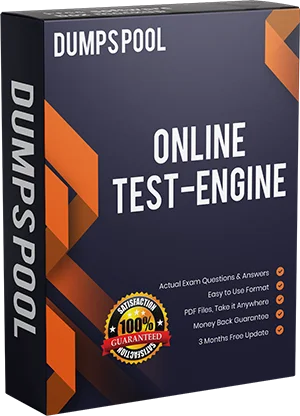PDF Only

$35.00 Free Updates Upto 90 Days
- 200-710 Dumps PDF
- 75 Questions
- Updated On July 26, 2024
PDF + Test Engine

$60.00 Free Updates Upto 90 Days
- 200-710 Question Answers
- 75 Questions
- Updated On July 26, 2024
Test Engine

$50.00 Free Updates Upto 90 Days
- 200-710 Practice Questions
- 75 Questions
- Updated On July 26, 2024
How to pass Zend 200-710 exam with the help of dumps?
DumpsPool provides you the finest quality resources you’ve been looking for to no avail. So, it's due time you stop stressing and get ready for the exam. Our Online Test Engine provides you with the guidance you need to pass the certification exam. We guarantee top-grade results because we know we’ve covered each topic in a precise and understandable manner. Our expert team prepared the latest Zend 200-710 Dumps to satisfy your need for training. Plus, they are in two different formats: Dumps PDF and Online Test Engine.
How Do I Know Zend 200-710 Dumps are Worth it?
Did we mention our latest 200-710 Dumps PDF is also available as Online Test Engine? And that’s just the point where things start to take root. Of all the amazing features you are offered here at DumpsPool, the money-back guarantee has to be the best one. Now that you know you don’t have to worry about the payments. Let us explore all other reasons you would want to buy from us. Other than affordable Real Exam Dumps, you are offered three-month free updates.
You can easily scroll through our large catalog of certification exams. And, pick any exam to start your training. That’s right, DumpsPool isn’t limited to just Zend Exams. We trust our customers need the support of an authentic and reliable resource. So, we made sure there is never any outdated content in our study resources. Our expert team makes sure everything is up to the mark by keeping an eye on every single update. Our main concern and focus are that you understand the real exam format. So, you can pass the exam in an easier way!
IT Students Are Using our Zend Certified Engineer Dumps Worldwide!
It is a well-established fact that certification exams can’t be conquered without some help from experts. The point of using Zend Certified Engineer Practice Question Answers is exactly that. You are constantly surrounded by IT experts who’ve been through you are about to and know better. The 24/7 customer service of DumpsPool ensures you are in touch with these experts whenever needed. Our 100% success rate and validity around the world, make us the most trusted resource candidates use. The updated Dumps PDF helps you pass the exam on the first attempt. And, with the money-back guarantee, you feel safe buying from us. You can claim your return on not passing the exam.
How to Get 200-710 Real Exam Dumps?
Getting access to the real exam dumps is as easy as pressing a button, literally! There are various resources available online, but the majority of them sell scams or copied content. So, if you are going to attempt the 200-710 exam, you need to be sure you are buying the right kind of Dumps. All the Dumps PDF available on DumpsPool are as unique and the latest as they can be. Plus, our Practice Question Answers are tested and approved by professionals. Making it the top authentic resource available on the internet. Our expert has made sure the Online Test Engine is free from outdated & fake content, repeated questions, and false plus indefinite information, etc. We make every penny count, and you leave our platform fully satisfied!
Frequently Asked Questions
Question # 1
When retrieving data from URLs, what are valid ways to make sure all file_get_contents calls send a certain user agent string? (Choose 2)
A. $default_opts = array('http'=>array('user_agent'=>"My Cool Browser")); $default = stream_context_set_default($default_opts);
B. stream_context_set_option("user_agent", "My Cool Browser");
C. ini_set('user_agent', "My Cool Browser");
D. stream_context_set_option($context, "http", "user_agent", "My Cool Browser");
Question # 2
Which of these error types may be handled by a user defined error handler function? (Choose two.)
A. E_ERROR
B. E_NOTICE
C. E_PARSE
D. E_WARNING
Question # 3
When would you use classes and when would you use namespaces?
A. Use classes to encapsulate code and represent objects, and namespaces to avoid symbol name collisions
B. Use classes for performance-sensitive code, and namespaces when readability matters
more
C. Use namespaces for performance-sensitive code, and classes when readability matters more
D. Always use them; namespaces are always superior to classes
Question # 4
Which of the following are valid identifiers? (Choose 3)
A. function 4You() { }
B. function _4You() { }
C. function object() { }
D. $1 = "Hello";
E. $_1 = "Hello World";
Question # 5
What is the method used to execute XPath queries in the SimpleXML extension?
A. xpathQuery()
B. xpath()
C. simpleXMLXpath()
D. query()
E. evaluate()
Question # 6
Consider the following table data and PHP code. What is the outcome? Table data (table name "users" with primary key "id"): PHP code (assume the PDO connection is correctly established): $dsn = 'mysql:host=localhost;dbname=exam'; $user = 'username'; $pass = '********'; $pdo = new PDO($dsn, $user, $pass); $cmd = "SELECT * FROM users WHERE id = :id"; $stmt = $pdo->prepare($cmd); $id = 3; $stmt->bindParam('id', $id); $stmt->execute(); $stmt->bindColumn(3, $result); $row = $stmt->fetch(PDO::FETCH_BOUND);
A. The database will return no rows.
B. The value of $row will be an array.
C. The value of $result will be empty.
D. The value of $result will be 'gamma@example.net'.
Question # 7
Type hinting in PHP allows the identification of the following variable types: (Choose 2)
A. String
B. Integer
C. Array
D. Any class or interface type
E. All of the above
Question # 8
What is the result of the following code? class T { const A = 42 + 1; } echo T::A;
A. 42
B. 43
C. Parse error
Question # 9
Under what condition may HTTP headers be set from PHP if there is content echoed prior to the header function being used?
A. headers_sent() returns true
B. Output buffering is enabled
C. The client supports local buffering
D. The webserver uses preemptive mode
Question # 10
What will an opcode cache ALWAYS automatically improve?
A. Running time of a loop in a PHP script
B. Efficiency of HTML markup generated by a PHP script
C. Execution speed of a PHP script
D. Memory footprint of a PHP script
E. None of the above
Question # 11
Which of the following will NOT instantiate a DateTime object with the current timestamp?
A. $date = new DateTime();
B. $date = new DateTime('@' . time());
C. $date = new DateTime('now');
D. $date = new DateTime(time());
Question # 12
How many elements does the array $matches from the following code contain? $str = "The cat sat on the roof of their house."; $matches = preg_split("/(the)/i", $str, -1, PREG_SPLIT_DELIM_CAPTURE);
A. 2
B. 3
C. 4
D. 7
E. 9
Question # 13
Is the following code vulnerable to SQL Injection ($mysqli is an instance of the MySQLi class)? $age = $mysqli->real_escape_string($_GET['age']); $name = $mysqli->real_escape_string($_GET['name']); $query = "SELECT * FROM `table` WHERE name LIKE '$name' AND age = $age"; $results = $mysqli->query($query);
A. No, the code is fully protected from SQL Injection.
B. Yes, because the $name variable is improperly escaped.
C. Yes, because the $name variable and the $age variable is improperly escaped.
D. Yes, because the $age variable is improperly escaped.
E. Yes, because you cannot prevent SQL Injection when using MySQLi
Question # 14
Consider the following table data and PHP code. What is the outcome? Table data (table name "users" with primary key "id"): id name email ------- ----------- ------------------- 1 anna alpha@example.com 2 betty beta@example.org 3 clara gamma@example.net 5 sue sigma@example.info PHP code (assume the PDO connection is correctly established): $dsn = 'mysql:host=localhost;dbname=exam'; $user = 'username'; $pass = '********'; $pdo = new PDO($dsn, $user, $pass); try { $cmd = "INSERT INTO users (id, name, email) VALUES (:id, :name, :email)"; $stmt = $pdo->prepare($cmd); $stmt->bindValue('id', 1); $stmt->bindValue('name', 'anna'); $stmt->bindValue('email', 'alpha@example.com'); $stmt->execute(); echo "Success!"; } catch (PDOException $e) { echo "Failure!"; throw $e; }
A. The INSERT will succeed and the user will see the "Success!" message.
B. The INSERT will fail because of a primary key violation, and the user will see the "Success!" message.
C. The INSERT will fail because of a primary key violation, and the user will see a PDO warning message.
D. The INSERT will fail because of a primary key violation, and the user will see the "Failure!" message.
Question # 15
What is the output of the following code? class A { public $a = 1; public function __construct($a) { $this->a = $a; } public function mul() { return function($x) { return $this->a*$x; }; } } $a = new A(2); $a->mul = function($x) { return $x*$x; }; $m = $a->mul(); echo $m(3);
A. 9
B. 6
C. 0
D. 3
Leave a comment
Your email address will not be published. Required fields are marked *